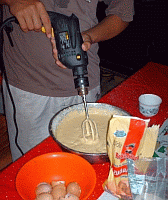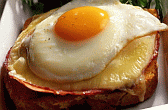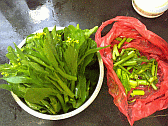|
|
| Chinese
Recipes |
Pi Gwat or
Chinese Style Ribs |
|
Chinese style pork ribs are a group
of dishes known collectively as Pi Gwat. These are not
dishes you would know of in the west unless you have
visited China.
Spare Ribs as known in the west are detailed separately,
and you can find an excellent recipe here.
For these dishes pork ribs are generally chopped into
cubes about 1 or 2 inches square. We will now detail
a few of the many popular recipes:
Basic Preparation for all Dishes
1. Your Chinese meat provender will
chop these to the required size for you, or you can
buy whole ribs and do it yourself. Wash the pork meat
and set aside in a bowl.
2. Dice a 3-inch chunk of peeled
fresh, wet ginger into wafer thin strips. Hold
in your fist over the meat and squeeze as much
juice out of the ginger as possible. Discard the
remnant, mixing the meat so it all gets covered
in the ginger juice..
3. Smash
3 or 6 Chinese garlic and remove the husks. Roughly
chop the garlic and add to the meat, stirring
well in. If using western garlic, then add half
to one whole wardrobe (Bulb).
4.
Cover with a mesh basket or cloth in order to
keep insects away. Marinade for at least 30 minutes,
and longer is better.
|
 |
| |
|
Recipe 1 - Steamed Pi Gwat
This is very simple, and the one served
at most Chinese Tea Houses:
Take the whole marinade and place into a
wok-steamer. For a portion size, place some
marinated meat on a saucer sized dish and
add to a bamboo or wok steamer.
A Wok steamer is simply a wok with a tripod
spacer in it. Water is added to below the
spacer height, and food added. Cover and
steam.
A bamboo steamer is a Bain Marie type of
affair consisting of large circular bamboo
dividers that are placed on top of the wok,
and can be stacked quite high. The topmost
should have a bamboo lid.
|
 |
For individual portions, steam
for 10 minutes until cooked, or leave for
longer = no problem. If cooking all the
meat, then increase cooking time to between
20 and 30 minutes - it depends how much
you are cooking really.
This is a standard 'Dim Sum' dish, that
you could think of as an entree (starter).
Whilst you can present to table in small,
low sided bowls; this should properly be
served in individual sized bamboo containers
- see picture right above. |
|
|
Recipe 2 - Pi Gwat Garlic
Crunch
For this dish only: marinade as above, but ensure
the garlic is diced into very small grains. You
should also buy ribs that are very thin, and chop
them into longer sections of about 3 inches.
Prepare some flour by sieving twice to remove
lumps and distribute the gluten. You can add this
to a small dish for ease of use, and add complementary
spices. Westerners will like both a little salt
and pepper added to the flour and mixed well in.
You can vary by adding a little: chilli powder
or curry powder to the flour - the latter being
totally fantastic!
To cook, stir the marinade well ensuring garlic
sticks to every piece of meat. Dust with the flour
mixture and put into a hot wok with a full base
of oil. Turn after 30 seconds, and keep tossing
until the surface sets. Reduce the heat immediately
and simmer for a few minutes. Turn when light
yellow, and repeat. Remove from the heat and place
on a rack to finish cooking internally. Heat the
oil after a couple of minutes, and flash-fry for
30 seconds turning once, or until lightest golden
brown. Serve immediately.
There is great skill in perfecting this dish,
as getting the frying wrong you either end up
with bloody meat, burnt batter, and probably both!
Use too little heat initially, and you will have
a wok full of ribs, and separate lumps of burnt
flour. This is why we suggest at least one resting
period, so the meat continues cooking, whilst
the outside does not. However, once you get the
hang of cooking this the results are totally delicious. |
Recipe 3 - Pi Gwat
in Blackbean Sauce |
a. Add a
little oil to your wok and flash-fry the whole
marinade so as to seal the meat. This should take
30 seconds or so, as you do not want to burn the
garlic. Add a couple of tablespoons of Blackbean
sauce from a pre-mixed jar, and turn down the
heat to a simmer.
b. Once
bubbling away nicely, you may want to add a little
water or vegetable stock to prevent it becoming
too thick = it will start to stick and burn if
you are not careful..
c. Simmer
for at least 10 minutes stirring occasionally
and adding extra water as required.
d.
Check the taste, which should be great.
You can add a little salt and pepper if you prefer,
but this dish doesn't really need either.
e. Transfer to a serving
dish and present to table.
f.
For a flourish; add a few halved cherry
tomatoes as a rose to the centre and top with
chopped fresh parsley or coriander leaves.
|
Recipe 4 - Pi Gwat in Plum Sauce |
a. Add a little oil to your wok
and flash-fry the whole marinade so as to seal
the meat. This should take 30 seconds or so, as
you do not want to burn the garlic. Add a tablespoons
of Plum sauce from a pre-mixed jar, and turn down
the heat to a simmer.
b. Once
bubbling away nicely, you may want to add a little
water or vegetable stock to prevent it becoming
too thick = it will start to stick and burn if
you are not careful..
c. Simmer
for at least 10 minutes stirring occasionally
and adding extra water as required.
d.
Check the taste, which should be great.
You can add a little salt and pepper if you prefer,
but this dish doesn't really need either.
e. Transfer the meat to a serving
dish and add the plum sauce and juices from the
wok by pouring over the ribs, and present to table.
f. For a more western look, use
longer chops of spare ribs.
g. To make a sweeter dish, marinade
in Plum Sauce instead of the ginger and garlic,
turning occasionally. Add to the wok with another
tablespoon of Plum Sauce, and be ready to add
a little water to stop sticking and burning.
|
The following recipes all
link together:
Recipe 5 - Pi Gwat in Gravy
|
This recipe is prepared just as
above, except we will not be adding blackbean
sauce. Instead as soon as the meat is sealed we
turn down the heat and sprinkle it with chicken
bouillon granules. Stir for 20 seconds and add
water or stock, returning the mix to a simmer.
Stir well over the next couple of minutes, adding
more water or stock as necessary. Simmer for 15
minute, stirring occasionally. Develop the natural
gravy over the last 5 minutes, adjusting the thickness
to your liking = add water to make it thinner,
simmer to make it thicker.
Once you are happy and getting ready to dish-up,
taste the sauce. Like me you will probably think
it needs a little ground black pepper and some
salt. Adding salt will fix the final flavour,
and being added so late in the cooking you should
use refined or table salt. Kosher or rock salt
does not have enough time to mix properly, but
if added earlier destroys the subtle flavour's
we are seeking. If you must use kosher salt, then
mix this into a brine before adding.
Plate for table and garnish as you prefer.
Recipe 6 - Pi Gwat Wok Pot
This is basically the same as above, only this
time we are adding vegetables to the mix. We pick
this up again once the meat is sealed. Alternatively
you could use pork meat, or any other meat for
that matter.
We add 1 tablespoon of chicken bouillon granules
as stir well in. Add to this enough water to cover
the meat and return to a simmer. This time we
add more water or stock if you prefer, because
we are cooking vegetables also.
You can add any vegetables you like, but keep
them to a smaller size so they will cook quicker.
We would recommend: Potatoes, Celery, onions,
peeled and sliced water chestnuts, Chinese whole
'long stick' or 'straw' mushrooms; adding capsicum
peppers a few minutes before serving - so they
are still a little crisp.
Chinese usually add carrots, which are fine except
I find they are usually a little too sweet. You
can add anything else you fancy.
Add a teaspoon of ground black pepper once the
ingredients are settled, and leave to simmer for
10 minutes, stirring occasionally.
Taste, and it should be quite delicious by now,
but needs a little salt perhaps? Again I would
add refined salt, as we are serving in about five
minutes, or at least as soon as all the vegetables
are properly cooked. Stir well over the final
few minutes of cooking, and adjust the gravy to
your preference.
Plate and serve to table with a little garnish.
Recipe 7 - Hot Pot
As an alternative you can serve this as a casserole
in a tall Chinese soup pot. The method is basically
the same again, except this time we are going
to put the ingredients into the large soup pot.
You can still seal the meat, or add the whole
marinade to the crock.
This time I would add the carrots, both types
of mushroom, and chop all the vegetables a little
larger. However I would not add the chicken bouillon
to this dish. Add the black pepper, salt, and
capsicums as well, so all our remaining ingredients
are in the pot. Top up with water (allow 1-inch
for expansion) and set to bubble away for at least
one hour, and preferably 90 minutes.
Check every 10 minutes or so, adding more water
as required, and also giving it a quick and gentle
stir.
This dish is quite flexible re cooking time, so
it allows a few minutes for other dishes to be
prepared, and dinner guests to arrive.
Present to table in its crock-pot, and serve each
guest a bowl of 'soup', perhaps with the odd morsel
in it.
Summary
You are perhaps by now realising what delicate
and subtle differences make to Cantonese dishes.
Flavour's can be altered by changing the cooking
method, using basically the same ingredients. |
|
|
|
This information is as supplied by ourselves, and ably
supported by our friends and various internet portals. |
|
| Search
this Website |
|
|
| Boy
Cooking |
 |
| Béchamel Related |






|
| Descriptions |











|
| Chinese Recipes |



|
|